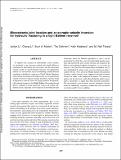| dc.contributor.author | Li, Junlun | |
| dc.contributor.author | Morton, Scott A. | |
| dc.contributor.author | Dohmen, Ted | |
| dc.contributor.author | Katahara, Keith | |
| dc.contributor.author | Toksoz, M. Nafi | |
| dc.contributor.author | Li, Chang, Ph.D. | |
| dc.date.accessioned | 2015-11-04T16:48:36Z | |
| dc.date.available | 2015-11-04T16:48:36Z | |
| dc.date.issued | 2014-07 | |
| dc.date.submitted | 2014-02 | |
| dc.identifier.issn | 0016-8033 | |
| dc.identifier.issn | 1942-2156 | |
| dc.identifier.uri | http://hdl.handle.net/1721.1/99713 | |
| dc.description.abstract | To improve the accuracy of microseismic event locations, we developed a new inversion method with double-difference constraints for determining the hypocenters and the anisotropic velocity model for unconventional reservoirs. We applied this method to a microseismic data set monitoring a Middle Bakken completion in the Beaver Lodge area of North Dakota. Geophone arrays in four observation wells improved the ray coverage for the velocity inversion. Using an accurate anisotropic velocity model is important to correctly assess the height growth of the hydraulically induced fractures in the Middle Bakken. Our results showed that (1) moderate-to-strong anisotropy exists in all studied sedimentary layers, especially in the Upper and Lower Bakken shale formations, where the Thomsen parameters (ϵ and γ) can be greater than 0.4, (2) all the events selected for high signal-to-noise ratio and used for the joint velocity inversion are located in the Bakken and overlying Lodgepole formations, i.e., no events are detected in the Three Forks formation below the Bakken, and (3) more than half of the strong events are in two clusters at approximately 100 and 150 m above the Middle Bakken. Reoccurrence of strong, closely clustered events suggested activation of natural fractures or faults in the Lodgepole formation. The sensitivity analysis for the inversion results showed that the relative uncertainty in parameter δ is larger than other anisotropy parameters. The microseismic event locations and the anisotropic velocity model are validated by comparing synthetic and observed seismic waveforms and by S-wave splitting. | en_US |
| dc.description.sponsorship | Shell Oil Company | en_US |
| dc.language.iso | en_US | |
| dc.publisher | Society of Exploration Geophysicists | en_US |
| dc.relation.isversionof | http://dx.doi.org/10.1190/GEO2013-0345.1 | en_US |
| dc.rights | Article is made available in accordance with the publisher's policy and may be subject to US copyright law. Please refer to the publisher's site for terms of use. | en_US |
| dc.source | Society of Exploration Geophysicists | en_US |
| dc.title | Microseismic joint location and anisotropic velocity inversion for hydraulic fracturing in a tight Bakken reservoir | en_US |
| dc.type | Article | en_US |
| dc.identifier.citation | Li, Junlun, Chang Li, Scott A. Morton, Ted Dohmen, Keith Katahara, and M. Nafi Toksoz. “Microseismic Joint Location and Anisotropic Velocity Inversion for Hydraulic Fracturing in a Tight Bakken Reservoir.” Geophysics 79, no. 5 (July 21, 2014): C111–C122. © 2014 Society of Exploration Geophysicists | en_US |
| dc.contributor.department | Massachusetts Institute of Technology. Department of Earth, Atmospheric, and Planetary Sciences | en_US |
| dc.contributor.department | Massachusetts Institute of Technology. Earth Resources Laboratory | en_US |
| dc.contributor.mitauthor | Li, Junlun | en_US |
| dc.contributor.mitauthor | Toksoz, M. Nafi | en_US |
| dc.relation.journal | Geophysics | en_US |
| dc.eprint.version | Final published version | en_US |
| dc.type.uri | http://purl.org/eprint/type/JournalArticle | en_US |
| eprint.status | http://purl.org/eprint/status/PeerReviewed | en_US |
| dspace.orderedauthors | Li, Junlun; Li, Chang; Morton, Scott A.; Dohmen, Ted; Katahara, Keith; Nafi Toksoz, M. | en_US |
| dc.identifier.orcid | https://orcid.org/0000-0002-4851-3089 | |
| mit.license | PUBLISHER_POLICY | en_US |
| mit.metadata.status | Complete | |
